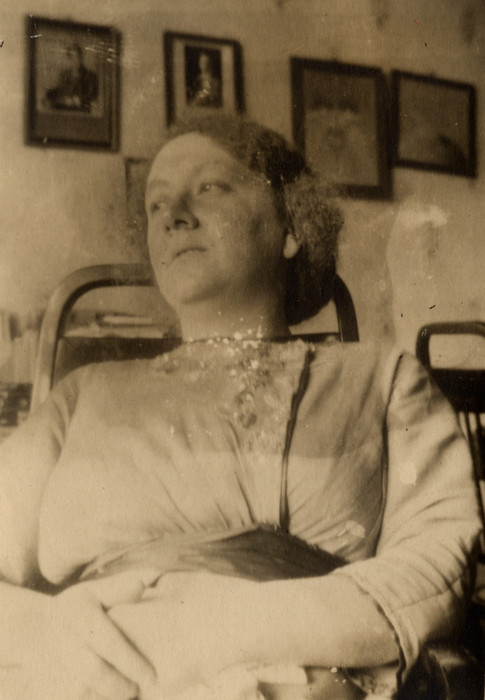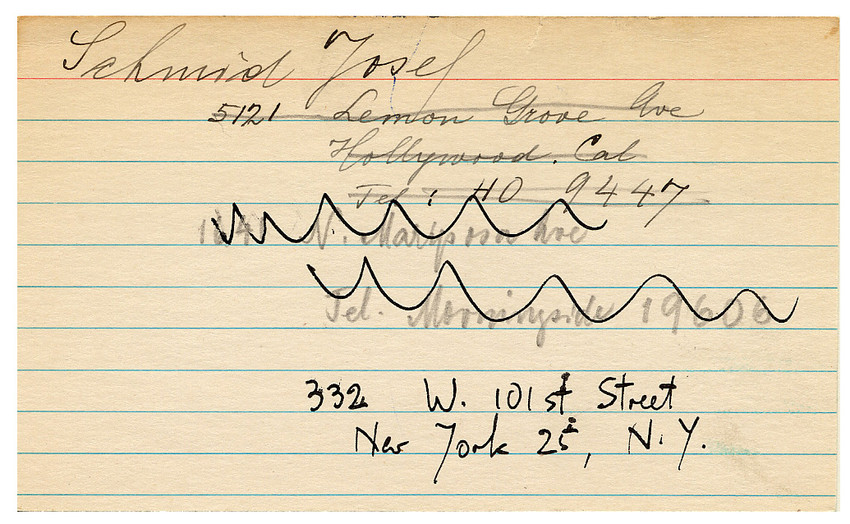A missing photograph of Gustav Mahler with a dedication to Arnold Schoenberg has recently been found in the San Fernando Valley. The photo was given to Schoenberg probably before Mahler’s departure to New York in 1907. You can see it hanging on the wall above Schoenberg’s desk (to the left, below Schoenberg’s portrait of Mahler) in this photo from around 1912.  My aunt Nuria remembers seeing the photo when she was growing up, so it must have also hung in the Schoenberg study at least through the mid-1950s (when Nuria moved to Venice, Italy). When my grandmother Gertrud died in early 1967, after a brief illness, the study was locked up and made available only to scholars. In the early 1970s, Sonja Lane began working on a catalogue which was then used by Charles Sachs as an inventory when the archives were donated to the University of Southern California. The photograph does not appear in that inventory, and there is no trace of it having been at USC. Nuria noticed that the photo with Mahler’s dedication, and the companion photo of Mahler, were missing between 1987 and 1991 when she was working at the archives at USC on her document biography, Lebensgeschichte in Begengungen. She found empty frames that she believed were the frames that had housed the photos, but could not locate the photos themselves.
My aunt Nuria remembers seeing the photo when she was growing up, so it must have also hung in the Schoenberg study at least through the mid-1950s (when Nuria moved to Venice, Italy). When my grandmother Gertrud died in early 1967, after a brief illness, the study was locked up and made available only to scholars. In the early 1970s, Sonja Lane began working on a catalogue which was then used by Charles Sachs as an inventory when the archives were donated to the University of Southern California. The photograph does not appear in that inventory, and there is no trace of it having been at USC. Nuria noticed that the photo with Mahler’s dedication, and the companion photo of Mahler, were missing between 1987 and 1991 when she was working at the archives at USC on her document biography, Lebensgeschichte in Begengungen. She found empty frames that she believed were the frames that had housed the photos, but could not locate the photos themselves. 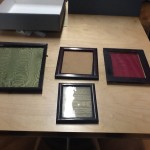 She reported this to the archivist R. Wayne Shoaf. After the archives were moved in 1997 to the Arnold Schönberg Center in Vienna, Nuria again told the new archivist, Therese Muxeneder, that these photos were missing.
She reported this to the archivist R. Wayne Shoaf. After the archives were moved in 1997 to the Arnold Schönberg Center in Vienna, Nuria again told the new archivist, Therese Muxeneder, that these photos were missing.
In late July 2012, a man named Cliff Fraser Jr., using the e-mail address cfpronto@aol.com, e-mailed this image of the missing photograph to the Schönberg Center in Vienna saying “Hello, my name is Cliff and recently acquired a document concerning Gustav Mahler and Arnold Schoenberg. I was hoping that you could help me understand its significance.”
He later wrote “my grandfather [Abraham (Abe) Fraser] was a music teacher and took composition classes in the 1950’s from Joseph Schmidt [sic], a former student of Schoenberg. [M]y Grandfather died in 1987 and I just found the picture berried [sic] in back of the boiler room of his house (I could hardly see through the frame; I almost threw it away). I’m guessing that Schoenberg willed it to Schmidt who willed it to my grandfather. Amazing…”
Of course, Schoenberg did not mention this photo in his will, which gave his entire estate to his widow Gertrud Schoenberg. Josef Schmid (1890-1969) was a pupil of Alban Berg, not Schoenberg. In 1940, Schoenberg wrote to Robert Emmett Stuart “There live in America also two pupils of Alban Berg: Dr. Wiesengrund-Adorno and Mr. Josef Schmid. If you are interested I will find their addresses. . . . Mr. Josef Schmied [sic] has been conductor in Prague, Berlin, and other places. He is a very good pianist, has studied theory with Berg. Whether he composes or not, is unknown to me.”
The Schönberg Center has an address card for Josef Schmid, with the notes: “Josef Schmid (born Germany, 1890 – died New York City, 1969) was a conductor, composer, and composition teacher. He was one of the first students of Alban Berg, with whom he studied before World War I. 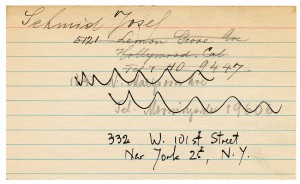 As a conductor Schmid had been an assistant to both Zemlinsky and Erich Kleiber. As a composer Schmid was associated with Berg and Webern but considered himself a musical “godson” of Schoenberg. After the War Schmid emigrated to New York City and established himself as a teacher of composition, basing his teaching on the writings of Schoenbergs.”
As a conductor Schmid had been an assistant to both Zemlinsky and Erich Kleiber. As a composer Schmid was associated with Berg and Webern but considered himself a musical “godson” of Schoenberg. After the War Schmid emigrated to New York City and established himself as a teacher of composition, basing his teaching on the writings of Schoenbergs.”
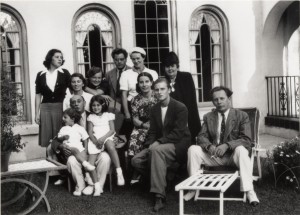
First row left to right: Arnold, Ronald and Nuria Schoenberg, Mitzi Weiss, Werner Klemperer, Adolph Weiss. Second row: Unidentified woman, Gertrud Schoenberg, unidentified woman, Mr. & Mrs. Joseph Schmid, Mrs. Joseph Achron. Taken in front of the Brentwood home.
Based on the autobiography of Schmid’s pupil Joe Maneri, Cliff claimed that Schmid came to the United States in 1936 with the assistance of Schoenberg. There is a group photo taken in front of the Schoenberg home in Los Angeles around 1940 that shows Schmid and his wife visiting the Schoenbergs.
The Archive of the Arnold Schönberg Center in Vienna contains copies of a number of short letters and telegrams from Schmid to Schoenberg, such as this one from 1948 wishing happy birthday. 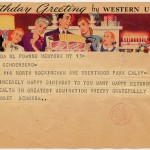 Schmid wrote two letters in September 1949 congratulating Schoenberg on his 75th birthday. In one of them, Schmid mentions the upcoming publication in book form of Schoenberg’s essays, recalling also Schoenberg’s lecture on Mahler in Vienna.
Schmid wrote two letters in September 1949 congratulating Schoenberg on his 75th birthday. In one of them, Schmid mentions the upcoming publication in book form of Schoenberg’s essays, recalling also Schoenberg’s lecture on Mahler in Vienna.
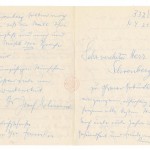
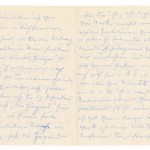 However, despite the fact that Schoenberg kept carbon copies of his letters, the correspondence archive does not contain any letters from Schoenberg to Schmid, indicating that it was a one-sided relationship of pupil (of a pupil) to master. A gift of the treasured Mahler photo from Schoenberg to Schmid seems highly unlikely.
However, despite the fact that Schoenberg kept carbon copies of his letters, the correspondence archive does not contain any letters from Schoenberg to Schmid, indicating that it was a one-sided relationship of pupil (of a pupil) to master. A gift of the treasured Mahler photo from Schoenberg to Schmid seems highly unlikely.
As this further evidence came to his attention, Cliff modified his theory to one even more unlikely, saying “It is far more likely that Schmid received the picture from Alban Berg.” However, there is no evidence of any gift of the photo from Schoenberg to Berg, despite the considerable documentation of their correspondence, including many letters referencing gifts. A gift to Berg, who died in 1935, is also inconsistent with Nuria’s recollection of the photograph at the Schoenberg home in Brentwood.
According to Cliff, his grandfather Abe Fraser “studied composition with Schmid in New York starting in 1951. In 1958 my Grandfather moved to LA and before his departure Schmid gave him the picture as a farewell gesture.” Based on information Cliff says he obtained from his grandmother, Abbey Fraser, who is apparently elderly and not well, Cliff stated that “this picture was a gift from my grandfather’s teacher.” However, Cliff’s father Dr. Cliff Fraser, Sr. says that his father Abe had a large autograph collection from people he had met, but he does not recall ever seeing the Mahler photograph.
At this stage, it is unclear what is true and what is simply a guess by Cliff in order to establish a provenance for the Mahler photograph. Cliff has behaved rather cagey throughout the whole process. Initially, he would not even provide his last name. He has refused to meet with us or speak to us on the phone. He will not let us see the photograph or the frame (which is obviously different from the original frame), nor will he send us any further pictures of them. At one point he referred us to his attorney “Paul” but did not provide a last name or any contact information and the attorney never contacted us. He wrote that his family wanted to sell the photo, then wrote that his grandmother had decided to keep the photo, and then, less than 24 hours later, wrote to us offering to sell it for $350,000. Cliff claimed to have a “notarized sworn declaration, under penalty of perjury” from his 94-year-old grandmother, supporting the claim that the photo was a gift to his grandfather, but then he refused to send us the declaration unless we agreed to purchase the photograph.
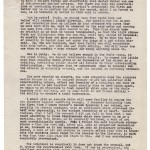
First page of the English version of Schoenberg’s essay on Mahler, which begins: “Instead of using my words, perhaps I should do best simply to say: I believe firmly and steadfastly that Gustav Mahler was one of the greatest men and artists”
In the view of the Schoenberg family, it appears likely that the photo was improperly taken at some point from the Schoenberg estate. It seems inconceivable that Schoenberg himself would ever have parted with such a treasured memento from his friend and benefactor Mahler. There is no evidence yet of any gift or sale of the photo by Arnold or Gertrud Schoenberg, who meticulously maintained the Schoenberg archives for decades. The very few items that were sold or given as gifts have all been well-documented. Given where the photo ended up, in Sherman Oaks, just a few miles away from the Schoenberg home in Brentwood, a more local trajectory seems likelier than the ones theorized by Cliff. Coincidentally, or not, there was an assistant university librarian at California State University, Los Angeles named Joseph Schmidt who worked on cataloguing the Schoenberg archives in 1973, before they were transferred to the Arnold Schoenberg Institute at USC. But it should be noted that no other items were noticed missing during the transfer of the archives from the Schoenberg home to USC. The photograph could very well have been taken prior to the transfer of the archives. [NB. The manuscript for the Op. 3 Songs had been microfilmed but is also now missing. Several drawings were taken from their frames and stolen during an exhibit at USC in the 1970s.]
Cliff has not disclosed what he intends to do next with the photograph. I will keep everyone posted on any further developments, and would welcome any information from the readers of this blog.
